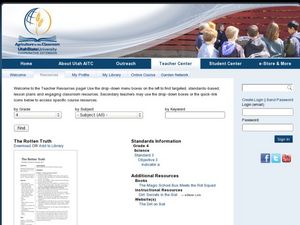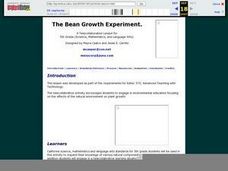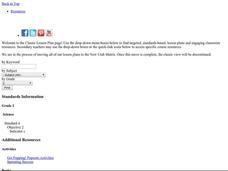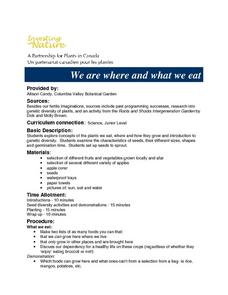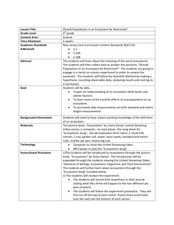Curated OER
The Rotten Truth
Fourth graders investigate compost. In this Science activity, 4th graders take notes on the components of soil and its relation to plant growth. Students describe the steps in making compost.
Curated OER
What Land Works Best?
Fourth graders explore different types of land. In this land instructional activity, 4th graders investigate how water, climate, and soil type determine what types of crops may be grown. Students discover these elements while playing an...
Curated OER
Plant and Animal Cells - Are they Different?
High schoolers observe the similarities and differences between plant and animal cells. In this cell activity, students use microscopes to observe self prepared slides of animal and plant cells.
Curated OER
The Bean Growth Experiment
Fifth graders use modern technologies which allow them to gain a new, dynamic, and intersting understanding of themselves, their community, and the world. They focus on environmental education and the effect of the environment on plant...
Curated OER
Soil Nutrients - Phosphorus Lab Lesson Plan
Learners list sources of phosphorus in soil. They explain how phosphorus is removed from the soil and used by plants. Students list the symptoms of insufficient or excess phosphorus. Learners perform experiments to examine the effect of...
Curated OER
Links in a Food Chain
Little ones make costumes and act out a rhyme in which there are daisies, bugs, wrens, snakes, and foxes that all interact in a food web. This would be a memorable activity for primary life scientists to participate in as a wrap-up...
Curated OER
I Can Solve Capacity Problems (3 Worksheets)
In this math worksheet, students read and solve 20 word problems in which they calculate capacity using basic addition or subtraction with regrouping. Note: All problems are in metric measurement only.
Curated OER
Science Crossword Puzzle
Class members read 25 clues about all areas of science, including biology, chemistry, weather, physical science, and insert their answers into a crossword puzzle. There is no word bank and the students would need experience with tough...
Curated OER
Terrariums for Project Pals
Students identify the components needed by plants to survive in the terrarium. For this biology lesson, students build their own terrariums using materials available. They present their project in class.
Curated OER
Enduring Understanding
Fourth graders explore indigenous people of rainforest and examine their customs and ways of life. They discuss how rainforests should be protected not only for their plants and animals, but also for indigenous people who live in them,...
Curated OER
Food Webs
Students identify predator/prey relationships based on the food web of the tropical rain forest ecosystem and realize they need a food web for survival. In this food web lesson plan, students complete a role play activity being animals...
Curated OER
My Little Seed House
Second graders explore plant life by participating in a germination activity. For this botany lesson, 2nd graders read several books about seed germination including Sunflower House and Tiny Seed. Students identify the necessary elements...
Curated OER
Fable of the Fainting Goat
Second graders explore animal life by reading children stories in class. In this goat fable lesson, 2nd graders read several books which describe the different myths and folklore about goats. Students identify the needs of living animals...
Curated OER
Food Chains
Have your class discuss food chains using this presentation. This resource goes through a step by step exploration of plants and the food chain. It talks about the energy of the sun, producers and consumers, herbivores and carnivores,...
Curated OER
Plant Growth
Students explore the parts of a plant and seed. They plant seeds and observe the growth of plants. Students record the observations. They discuss and share the observations they see.
American Museum of Natural History
Finding Fossils
How does one go about finding fossils? Find out with an informative webpage that looks at the digging process, showcases rocks and common fossils, helpful tips, and a list of archeological do's and don'ts.
Curated OER
Plant Collection II
Students mount their first pressed plant specimens and cover some basic plant morphology. They complete a homework assignment to practice their plant collecting and observational skills at home.
Curated OER
We are where and what we eat
Students explore concepts of plants they eat, where and how they grow and are introduced to genetic diversity. They examine seed characteristics, look at their different sizes, shapes and germination time. They also set up seeds to...
Curated OER
This Is Tree-rific!
Third graders view a clip of the video Backyard Safari, "Trees," and portray the life cycle of a tree. They also view a clip on structures of a tree and draw a diagram of a tree in their science journals.
Curated OER
Flower Power: Kansas Quarter Reverse
Students examine the Kansas quarter reverse and explore the basic needs and life processes of plants. They take a nature walk around the school and draw living and non-living things. In the classroom the sort the specimens collected into...
Curated OER
Introduction to Restoration Lesson
Students explore how pollution and invasive plants disrupt the ecosystem. In this restoration instructional activity students list materials that pollute wetlands, how people can keep them clean and ways in which invasive plants...
Curated OER
What Is It?
Play the game of Tag and differentiate between plants and animals. Explore the characteristics of plants. Identify the major parts of plants (e.g., seeds, stem, pistil) and describe their basic functions. Compare the requirements of some...
Curated OER
Leaves and Photosynthesis
In this science instructional activity, students read detailed information about green plants and the photosynthesis process. In this fill in the blank and true and false instructional activity, students answer twelve questions.
Curated OER
Should Populations in an Ecosystem be Restricted?
Fourth graders experiment to determine how overpopulation effects ecosystems specifically plants. In this ecosystem lesson, 4th graders conduct an ecosystems experiment after listening to Claire Daniel's, Ecosystems. They watch a video,...


